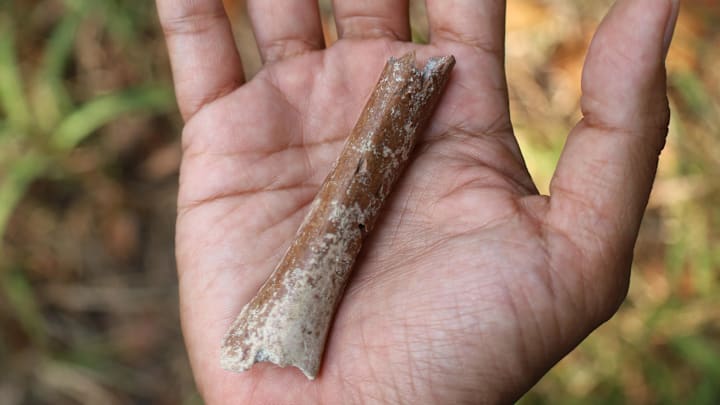For 20 years, the Indonesian island of Flores has presented an archaeological mystery.
In 2003, scientists exploring the Liang Bua Cave discovered the remains of an adult female hominin that lived about 60,000 years ago and stood 3 feet, 7 inches tall. The nearly complete skull and leg bones indicated she possessed a small head, a flattish face, short legs, and large, flat feet.
The archaeologists labeled the skeleton LB1, as in the first specimen from Liang Bua. Later, when describing the discovery in the journal Nature, the team named the new species Homo floresiensis [PDF]. This being the early 2000s, the press called her “the Hobbit.”
No other ancient hominins looked like the Hobbit, which set off a fierce debate: Was she a newly discovered branch of the human evolutionary tree? Or was she a Homo erectus or a member of another previously identified species with a genetic condition that affected her growth? If so, was that condition widespread on the island?
The presence of prehistoric tools and the fact that her ancestors apparently used boats to get to the island suggested she was from the smarter end of the evolutionary spectrum, but, frustratingly, Flores has offered scant additional clues. Archaeologists have found only small fragments of other skeletons.
But this week, researchers published an analysis of some of those fragments in the journal Nature Communications and conclude that much of the island’s Pleistocene-era population was petite.

Yousuke Kaifu of the University of Tokyo and colleagues examined fossilized teeth and a partial upper arm bone from 10 adults and 10 children or adolescents that date back 700,000 years. They probably belonged to an ancestor species of the Hobbit. The researchers estimate the hominins that left behind the fossils were between 9 and 16 percent smaller than the Homo floresiensis skeleton, making them the smallest ancient population from the genus Homo yet discovered.
This thinking aligns with the indications of related evidence found in 2019. That year, archaeologists discovered another small-bodied human ancestor, Homo luzonensis, on the island of Luzon in the Philippines. This one did not leave enough intact bones to determine an exact height, but it bolstered the islands-of-tiny-hominins theory.
The researchers behind the new paper theorize that Flores’s pint-sized prehistoric populace descended from Homo erectus, a human species that existed from 2 million years ago until about 100,000 years ago. Their height range was similar to that of modern humans.
So how did the population on Flores shrink? It could have been a founder effect, the loss of genetic variance after a population is cut off from a wider range of breeding partners. Also, larger species of animals isolated on islands tend to shrink to suit their environment through a process called island dwarfism. With fewer predators, the evolutionary advantages of largeness decline, and with fewer resources to sustain large bodies, the advantages of smallness increase. Though more research is needed to determine the causes, we do know that the Hobbits weren’t the only small life forms on prehistoric Flores: the island was also home to, adorably, 4-foot-tall elephants.
Read More Stories About Human Evolution:
